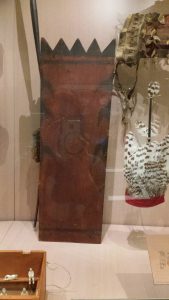
As we explored the Alaska State Museum on Friday, I found myself drawn to the exhibit on Inupiaq ceremony, music, and dance. The particular artifact that intrigued me was a musical instrument, a type of box drum called the Kaylukaq. This drum is Inupiaq in origin, and its maker is unknown. The kaylukaq came from a village in northern Alaska called Mary’s Igloo, also known as Qawiaramiut in Inupiaq. The drum was found between 1910 and 1921 by Dr. D. S. Neuman, however there are no exact dates for when this piece was made by the artist.
This artifact interests me because of its design and construction. It appears unique with respect to the other percussion instruments used in Inupiaq music. The instrument I have seen most commonly used in recorded performances of Inupiaq songs and dances is a large frame drum. This type of drum differs greatly from the kaylukaq in terms of materials, style, and shape. These particular frame drums used in dance music are circular with a very thin strip of bent wood used for the frame and a large piece of animal hide stretched over the frame for the drum head. This type of drum is held in the hand and struck with a stick or mallet. The kaylukaq, however, is strikingly different and seems unique and noteworthy for the ecological environment in which it is played.
The kaylukaq is a box drum, i.e. a drum made in the shape of a box. It is made from 6 thick pieces of wood, one wooden plank per side of the box. The drum is hung from the ceiling and struck with a mallet by the performer. The kaylukaq is associated with an Inupiaq winter festival called Kiviq, which translates to Messenger Feast. At the feast, an Inupiaq village hosts the leaders of neighboring villages in order to give gifts and engage in trade. It usually takes a full year to prepare for the festival, so the event happens only once a year. One of the main features of Kiviq is a series of dances called the Wolf Dances. These dances depict Inupiaq legends and honor animals hunted for food. The Wolf Dances are accompanied by the kaylukaq.
I find it very interesting that the kaylukaq is made of several large, thick pieces of wood. This is unusual because of the environment in which the Inupiaq live. The arctic far northern region of Alaska has very few trees and is mostly snow, ice, and flat tundra. It seems like it would be very difficult to find enough wood to construct a kaylukaq in an area where there are not many trees. I wonder if this factor makes the kaylukaq a rare and unique instrument? Does this scarcity of materials and challenge to construction give the kaylukaq special significance in ceremony, song, and dance?
The kaylukaq also shares similarities with a Latin American percussion instrument called the cajon. Like the kaylukaq, the cajon is also a box drum made from 6 pieces of wood. The cajon has a round hole on the back of the instrument, where sound resonates. In contrast to the kaylukaq, the cajon is played sitting down, with the performer sitting on top of the instrument and slapping the front panel of the box with his or her hands to make sound.
Some things I would like to know about the kaylukaq are:
1) How prevalent is the kaylukaq in Inupiaq music? Is it common or uncommon?
2) How often is it played?
3) Is it only associated with the festival of Kiviq?
Artifact Information:
Collected by Dr. D. S. Neuman, 1910-21
II-A-3681
Credit:
Kaylukaq Box Drum, courtesy of Alaska State Museum Juneau